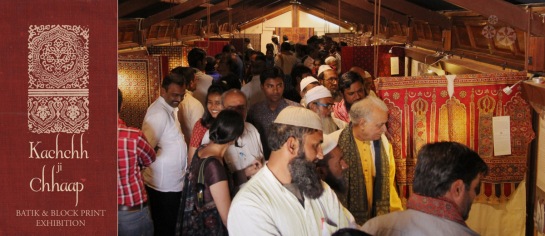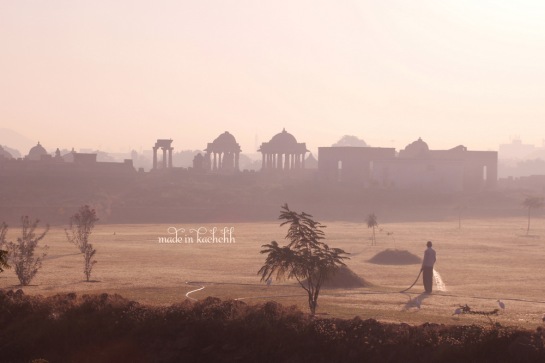Khalid’s advice to us, “Go home. Enough of film shooting. It is not good to go crazy about your work. It can be disastrous!”
The film team!

Watch the movie on youtube,
Even after all these years, Musabhai remembers precisely the printed motif that he sold to a businessman in Ahmedabad when he was just a teenager traveling out of Kachchh for the first time. He showed me the fabric sample and said, “I had made so many blocks myself and stored them all in my work shed in Dhamadka. Then the earthquake came, and the ground shook and the blocks were completely smashed! Not one survived. So I moved to Ajrakhpur and remade them all again!”
Musabhai today is a successful businessman. With his two sons helping him in printing and dyeing, theirs is one of the most visited shop in Ajrakhpur. What we went to document in film was his ‘businessman skills’ and what we received in return was a whole lot more.
“Is she understanding everything I am saying?” he asks pointing towards Sarah who is filming us.
“No Musabhai, I don’t think so. After going home, we both will sit together and translate every word that you said and then she will understand.”
“But my words are ok?”
“Your words are perfect!”
Later on, inside a workshop a few meters ahead, Khalid makes a beautiful hand printed and painted masterpiece, all the while making jokes about why we came to live in Kachchh and work at Khamir and what is our salary! Khalid is one of a kind artist…and person. Truly. Try talking to him and you will see how!
🙂
This short glimpse into the lives of Khatris of Ajrakhpur could well have been made into 5 films if not for Sarah’s super editing skills. So many laughs, discussions, debates, bad sound recordings and mutton meals later, we ended up with this. Those were indeed some special moments and I am glad Sarah could put it all together so nicely, in this film “A New Beginning In Ajrakhpur”.

Bringing together the Block printers and dyers of Kachchh and Khamir, our exhibition ‘Kachchh Ji Chhaap’ is now open!
The exhibition is an attempt to tell the story of prints and print making as it unfolded from the time it was practiced on the banks of the Indus to its many facets today. Kachchh Ji Chhaap is an intricate tale of the craftsmen, bringing together narratives of their lives, their milestones and their challenges.
The Exhibition will be held at the Khamir Campus from 7th December 2013 to 28th February 2014.

Winter is almost here. Our early morning walk and talk was beautiful last weekend at the Chatardi; the place where the Kings of Kutch buried their dead. Chatardi has a number of tombs built over several periods and lies in the heart of Bhuj City, close to the Hamirsar Lake.
It is believed that the main structure was erected to Rao Lakpatji, the most flamboyant King of Kutch who had a special interest for the arts. The Rao’s wife and 17 of their servants burnt themselves alive along with their beloved King. The Chatardi today lies in ruins after the many earthquakes that have engulfed this region and its architecture.
On my first drive into the Banni grasslands back in February, I had a hard time believing what the ecologist next to me was saying. At the time, we were on an empty highway heading due north. On either side of us the land was flat, brown and stretched out endlessly, scattered with a few tufts of dry grass and a lot of a small, hardy looking thorny tree species. I wondered idly why people called it a grassland. There wasn’t all that much grass in sight.
“It looks brown now,” he said, “but wait till it rains! The grass comes up and all the land you’re looking at turns into a marsh. It’s just water and grass, as far as you can see.” Another co-worker said, “Just wait till it rains, Banni turns into a golf course!”
I was skeptical. Even more so a few months on, when the summer heat hit Kachchh in earnest and Banni turned into a giant duster with towers of it scudding across the landscape. After every visit I went home with an unavoidable fine layer of grit embedded on my skin and in my teeth. Wait till it rains, they said. Word on the street was Kachchh might have another year of drought.
Banni is the subcontinent’s largest natural grassland, but it doesn’t always look that way. People who knew the area thirty or more years ago reminisce fondly about the height to which the grass would grow, the way it would be hard to spot a buffalo walking through it. It’s a difficult vision to conjure for those of us encountering Banni for the first time today. The spread of Prosopis juliflora, or Gando Baavar (Crazy Weed) as it is locally known, has been devastating. Fiercely invasive, Gando Baavar is everywhere. While there is grass, quite a bit of it, in the dry months a first time visitor would be forgiven for thinking they’d ventured into a particularly barren stretch of thorny forest rather than a grassland.
For 500 years or more, this region has been home to pastoralist communities, the Maldharis, who keep buffaloes and cows and graze their herds across the expanse of the land. What happens to your livelihood when your grazing dries up? Resourcefulness is a quality found in abundance here, from the structure of virdas, local water harvesting systems, to the buffaloes themselves, who are well adapted to their harsh environment and invariably find something to chew on.
Regardless, whenever there is good rain in some part of Banni, word spreads quickly and people move out with their herds. The communities living in the region of good rain never begrudge the presence of these travellers, and grazing is shared equitably. In Banni there is never any doubt that community welfare trumps the individual rat race, and the welfare of the animals is the ultimate priority. Wherever you go, you are welcomed, you are fed, you are family.
In September it rained for a week. There was lightning and thunder, downpours and flooded homes. In Bhuj, the lake overflowed prompting two days of public holidays. In the eastern belt of Banni though, where 300 families had migrated to avail of the grazing provided by earlier, sparser rains, things were difficult. A Maldhari friend who was there told me later that the water had been as high as his chest. Over 100 buffaloes drowned. “It’s not so hard for the maldhari with 30 or 40 buffaloes,” he reflected as we talked about the flood, “but what about the man who lost his only milk producers?”
That man, and others like him, will pull through. Their community will see to it that they do. Rain brings immense optimism to this water bereft land, and it is infectious. It’s hard not to look at the bright side. I find that my skepticism has dissolved and Banni is indeed a golf course.
On the way to a meeting in Banni the other day, we came upon a few Maldharis leading their buffaloes home from the eastern belt. We hopped out of the car to walk a while with them, till our paths diverged and we went on to our meeting while they turned toward their village. Despite recent events, the mood was calm, untroubled. In Banni, they had always known that the rain would turn up this year. But how?
“The buffaloes had the right body language,” one Maldhari said. “If the rain wasn’t going to come, they would have known.”
“How do you draw a camel?” A very valid question if one is trying to describe Kachchh in typical pictures. We are in our new second home, Ajrakhpur. Working on the poster for the upcoming exhibit. Rather than designing something on the computer, we want to print it on real cloth, fill the poster with life and real colour. So we went to design the poster together with Rauf and Khalid and especially Khalid, who would leave laughter lines on our faces.
Rauf is currently our source number one, who is accompanying us to visit many artisans across the region and helping us to connect to the Khatri community. Khalid, also a Blockprinter from Ajrakhpur, whom we met for the first time a few days back. A less worded, simple man. The kind of type I maybe would not recognize if he was walking by. Rauf told me he was the craziest man here in Ajrakhpur, I had some problems to imagine that “big boy” with the “I can not harm any fly” eyes to be the fanciest artisan around. But I was wrong. As soon as he started showing his pieces Krazy Khalid showed his face.
His pieces are different from everything we have seen until now. He does not care about traditional pattern, rules and the design of his ancestors. He has his own head. When everyone would print in the day he would print at night, when everyone bets on traditional pattern he would invent his own way of drawing. His own remark to his work: “There is no meaning at all, I am only taking some Blocks and putting them together to see whats happening.”
A real teaser. Stunned, amused and excited we decided to design the poster for the exhibition together with him.
We go the following day to his workshop.
Do we want something simple or complex? Should we layer it with colours and motifs? Should we use traditional blocks or make our own drawings?
What followed was a full day of work and play. Various ideas and laughing fits later we created several prints.
We used a resist dye on canvas cloth that we would later transform in colour by dyeing the cloth in indigo and red ( the traditional colours of blockprint)
Especially proud we are of the hand drawn camel and the little newspaper silhouette buffaloes which should represent the landscape of Kachchh.
So graphic designing with the artisans = success!
And what does the final design look like? You will see soon here on Made in Kachcch!